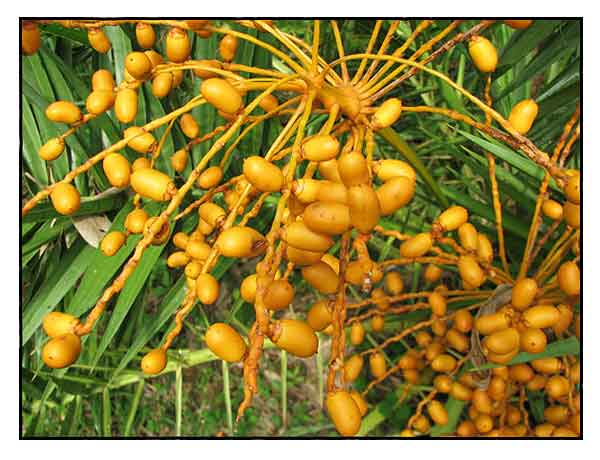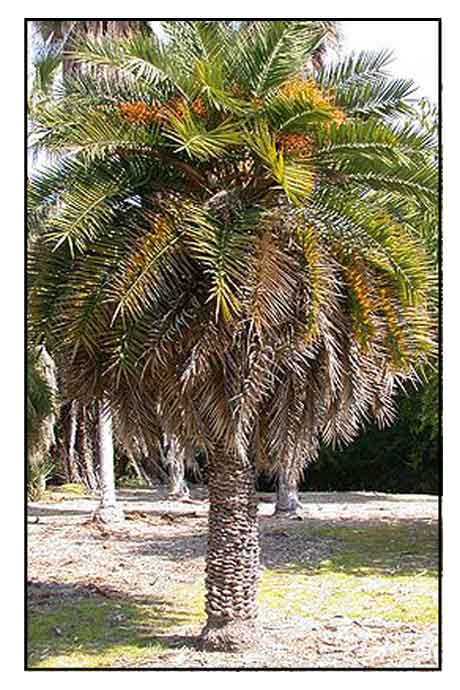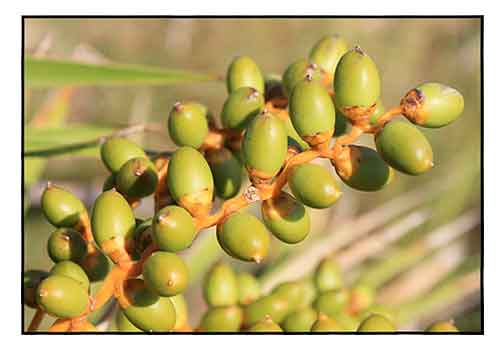 Gen info Gen info
- Araceae is one of the largest families in monocotyledons, consisting of 217 genera and more than 2,500 species.
-
Etymology: Species epithet loureiroi honors Joao de Loureiro, which was originally written by Kunth as loureiri, but since corrected to loureiroi.
Botany
Phoenix loureiroi is a solitary or clustering palm with trunks from 1–4 m high and 25 cm in width, usually covered in old leaf bases. Leaves vary to some degree but usually reach 2 m in length with leaflets wide at the base and sharply pointed apices. The leaflets emerge from the rachis at varying angles creating a stiff, plumose leaf. Fruit is a single-seeded drupe, bluish-black when ripe, produced on erect, yellow inflorescences, usually hidden within the leaf crown. (2)
Stems solitary or clustered, 1-6 m tall, 20-40 cm in diam., sometimes short and subterranean, rough with persistent, diamond-shaped leaf bases. Leaves to 2 m; sheath and petiole to 40 cm; rachis 1-2 m; acanthophylls ca. 15 per side of rachis; pinnae 40-130 per side of rachis, linear, irregularly arranged and spreading in different planes; middle pinnae 20-50 × 1-4 cm. Male inflorescences erect, to 65 cm, with to 30 rachillae, these ca. 10 cm; female inflorescences erect, becoming arched, to 2 m, with to 40 rachillae, these to 40 cm. Fruits black, blue-black, or dark purple, ovoid to obovoid, to 1.8 × 0.9 cm; endosperm homogeneous. (Flora of China) (4)
 Distribution Distribution
- Native to the Philippines.
- Also native to Assam, Bangladesh, Cambodia, China, Hainan, Himalaya, India, Laos, Myanmar, Nepal, Pakistan, Taiwan, Thailand, Vietnam.
(1)
- Grows primarily in the wet tropical biome.
- In deciduous and evergreen forests and in clear terrain from sea level to 1,500 m altitude.
Constituents
- Phytochemical screening of plant yielded glycosides, tannins, and flavonoids. (see study below) (6)
- Phytochemical screening of ethanol extract of leaves yielded sterols, flavonoids, saponins, proteins, reducing sugar, tannins, and phenolic acids. (see study below)
(10)
- Nutritive analysis of fruit
yielded high contents of total proteins (36.30 mg BSAE/g dry fruit), total free amino acids (6.15 mg LE/g dry fruit), reducing sugars (85.40 mg GE/g dry fruit), vitamin E (2.50 mg TE/g dry fruit) and sodium (1.26 mg/g dry fruit) at Rutab stage of maturation. Anti-nutritional constituents of fruit were found to be chymotrypsin inhibitors (3.31 CIU/mg protein), trypsin inhibitors (0.01 TIU/mg protein) and phytate (0.42 g phytate/100 g dry fruit) contents. HPTLC study yielded high amount of essential (tryptophan, 41.30 mg/g dry fruit) and non-essential (tyrosine, 25.70 mg/g dry fruit) amino acids. The total phenolics concentration was 49.68 mg GAE/100 g dry fruit. Liquid chromatography revealed high amounts of fructose (0.12 mg/g dry fruit), ascorbic acid (2.80 mg/g dry fruit), catechin (3.78 mg/g dry fruit) and succinic acid (1.57 mg/g dry fruit).
Properties
- Studies have suggest anti-inflammatory, antimicrobial, antioxidant, analgesic, antipyretic, cytotoxic properties.
Parts used
Leaves, fruits, thorns.
 Uses Uses
Edibility
- The apical bud is edible; sweet and eaten as vegetable (palm cabbage). (3)
- Fruits are sweet, a little mealy.
Folkloric
- In Tamil Nadu, Kurumba and Irula tribes consume the fruit to cure intestinal related diseases. (4)
- In south India, leaves and fruits used for treatment of dog bites. (9)
- In eastern Ghats, used for dysentery and ulcers.
- In Ayurveda, tender stems used for healing of osteoporotic fracture.
(12)
Others
- Crafts: Fibers are used to make the distinctive vakul headgear and kanayi vests of the Ivatan people in the Batanes Islands of northern Philippines. (2) Leaflets used for making of domestic products, such as mats and brooms. In the Philippines, shredded, sun-dried leaves are woven into raincoats. (3)
Studies
• Intestinal Anti-Inflammatory / Fruit: Study evaluated the preventive effect of plants fruits in inflammatory bowel disease (IBD) in Wistar albino rats induced by indomethacin, acetic acid, and dextran sulfate sodium, using measures of hematologic profile, biochemical and antioxidant levels. Fruit extract treated enterocolitic rats at doses of 50, 100, and 200 mg/kg significantly retained body weight, organ weight, stool consistency, macroscopic score, histology, hematological parameters, antioxidantive enzyme levels and also showed reduced serum marker levels and myeloperoxidase (MPO) activity compared to prednisolone (2mg/kg) and sulfasalazine (50mg/kg) drugs. Results suggest regular consumption of P. loureiroi fruit may prevent IBD and support folkloric use of fruit for treatment of intestinal ailments. (5)
• ZnO- and CTS-Encapsulated Nanoparticles / Antioxidant / Cytotoxic / Anti-Inflammatory / Fruit: Study reports on the synthesis of zinc oxide (ZnO)- and chitosan (CTS)-encapsulated nanoparticles using Phoenix loureiroi fruit. The biologically synthesized ZnO-CTS NPs exhibited high DPPH, ABTS, nitric oxide, hydroxyl radical scavenging activities and superoxide anion radical production. The cytotoxicity of the ZnO-CTS NPs revealed less hemolytic property (2.17%) and inhibited the Caco-s cancerous cell viability (IC50=70.45 µg/mL. Results suggest potential for pharmacotherapeutic applications in nano-herbal drug therapy. (6)
• Antimicrobial / Thorns: Study evaluated the antimicrobial activity of P. loureiroi thorn extract against E. coli, Bacillus and Streptococcus. Both aqueous and ethanolic extracts showed good activity against S. typhi, P. vulgaris, E. coli, Staphylococcus, Bacillus and Streptococcus. Crude extracts at 500 mg/ml dose showed potent activity against E. coli, Bacillus and Streptococcus. The ethanolic extract showed more potency than the aqueous extract. (7)
• Antibacterial / Fruit: Study evaluated the in-vitro antibacterial activity of P. loureiroi fruit ethanol, chloroform, and aqueous extracts against human pathogens, two gram-positives: B. subtilis and S. aureus, and five gram-negatives: E. coli, P. aeruginosa, K. pneumonia, S. typhimurium, S. marcescens by disc diffusion method. All three extracts showed positive effect against all tested microorganisms. (8)
• Analgesic / Antipyretic / Anti-Inflammatory / Leaves: Study evaluated the pharmacologic activities of ethanolic extracts of leaves at 200, 400, and 600 mg/kbw, per os in Swiss albino mice. Acute toxicity study using OECD guidelines showed lethal dose 50 (LD50) above 2,000 mg/kg and no reported death. The extract of leaves showed promising analgesic (writhing test for peripheral, tail immersion method for central), anti-inflammatory (carrageenan-induced rat paw edema) and antipyretic (yeast-induced hyperpyrexia method) activities. (see constituents above) (10)
• Nutritional Analysis / Cytotoxic Activity / Fruits: Study evaluated the nutritive values of Phoenix loureiroi fruits, organic compounds, polyphenolics and cytotoxic activity. The bioactive compounds of the fruit extract inhibited DPPH radical (IC50 8,51 µg/mL). Cell viability value of 65.87% on fibroblast L929 cell lines indicated the fruit extract was safe up to 1000 µg/mL concentration. Results suggest the fruit was rich in nutraceutical compounds and has potential for development of safe natural products. (see constituents above) (11)
Availability
-Wild-crafted.
- Seeds in the cybermarket.
|

![]()






